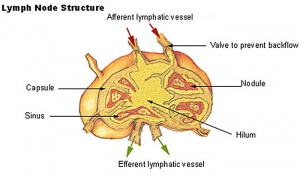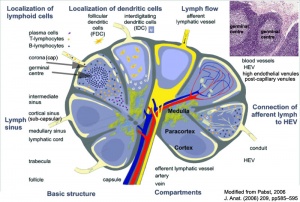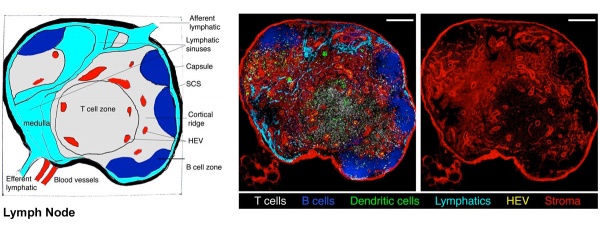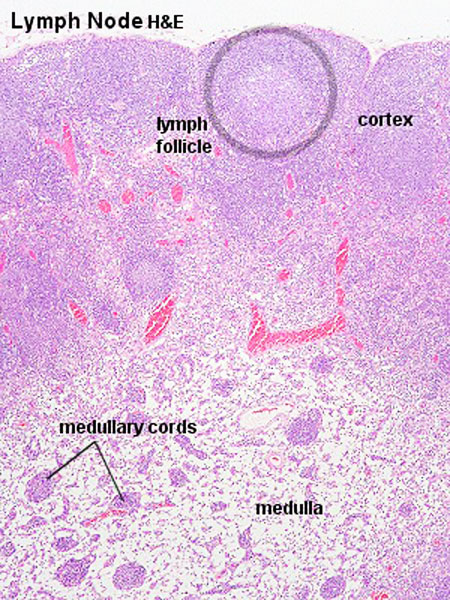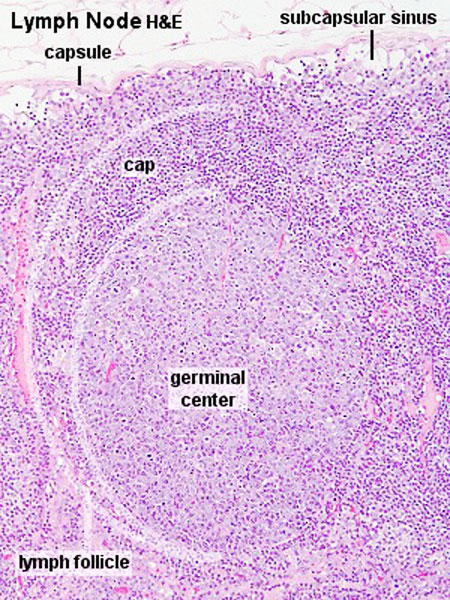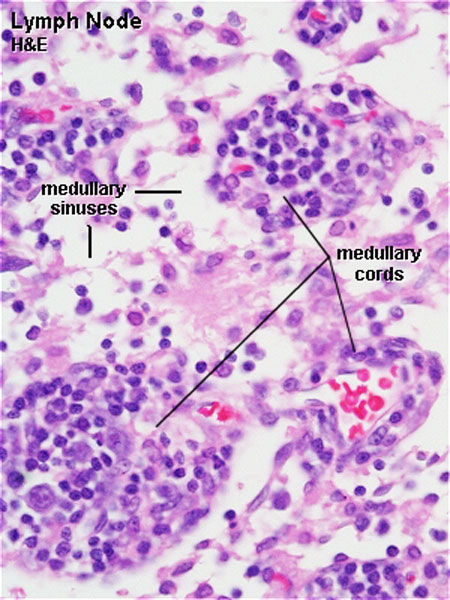Lymph Node Development: Difference between revisions
| Line 128: | Line 128: | ||
==References== | ==References== | ||
<references/> | <references/> | ||
===Textbook=== | |||
[http://www.ncbi.nlm.nih.gov/books/NBK10757/ '''Immunobiology'''] 5th edition The Immune System in Health and Disease Charles A Janeway, Jr, Paul Travers, Mark Walport, and Mark J Shlomchik. | |||
Part I. An Introduction to Immunobiology and Innate Immunity | |||
* Chapter 1. Basic Concepts in Immunology | |||
** [http://www.ncbi.nlm.nih.gov/books/NBK27092/ The components of the immune system] | |||
*** [http://www.ncbi.nlm.nih.gov/books/NBK27092/figure/A40 Figure 1.3 All the cellular elements of blood, including the lymphocytes of the adaptive immune system, arise from hematopoietic stem cells in the bone marrow] | |||
*** [http://www.ncbi.nlm.nih.gov/books/NBK27092/figure/A41 Figure 1.4 Myeloid cells in innate and adaptive immunity] | |||
*** [http://www.ncbi.nlm.nih.gov/books/NBK27092/figure/A42 Figure 1.5 Lymphocytes are mostly small and inactive cells] | |||
*** [http://www.ncbi.nlm.nih.gov/books/NBK27092/figure/A43 Figure 1.6 Natural killer (NK) cells] | |||
*** [http://www.ncbi.nlm.nih.gov/books/NBK27092/figure/A45 Figure 1.7 The distribution of lymphoid tissues in the body] | |||
*** [http://www.ncbi.nlm.nih.gov/books/NBK27092/figure/A47 Figure 1.8 Organization of a lymph node] | |||
*** [http://www.ncbi.nlm.nih.gov/books/NBK27092/figure/A48 Figure 1.9 Organization of the lymphoid tissues of the spleen] | |||
*** [http://www.ncbi.nlm.nih.gov/books/NBK27092/figure/A49 Figure 1.10 Organization of typical gut-associated lymphoid tissue] | |||
*** [http://www.ncbi.nlm.nih.gov/books/NBK27092/figure/A51 Figure 1.11 Circulating lymphocytes encounter antigen in peripheral lymphoid organs] | |||
** [http://www.ncbi.nlm.nih.gov/books/NBK27092/#A52 Summary to Chapter 1] | |||
Part III. The Development of Mature Lymphocyte Receptor Repertoires | |||
* Chapter 7. The Development and Survival of Lymphocytes | |||
** [http://www.ncbi.nlm.nih.gov/books/NBK27123/ Generation of lymphocytes in bone marrow and thymus] | |||
*** [http://www.ncbi.nlm.nih.gov/books/NBK27123/figure/A803 Figure 7.3 The early stages of B-cell development are dependent on bone marrow stromal cells] | |||
*** [http://www.ncbi.nlm.nih.gov/books/NBK27123/figure/A806 Figure 7.5 The development of a B-lineage cell proceeds through several stages marked by the rearrangement and expression of the immunoglobulin genes] | |||
*** [http://www.ncbi.nlm.nih.gov/books/NBK27123/figure/A809 Figure 7.7 The cellular organization of the human thymus] | |||
*** [http://www.ncbi.nlm.nih.gov/books/NBK27123/figure/A818 Figure 7.13Thymocytes at different developmental stages are found in distinct parts of the thymus] | |||
** [http://www.ncbi.nlm.nih.gov/books/NBK27150/ Survival and maturation of lymphocytes in peripheral lymphoid tissues] | |||
** [http://www.ncbi.nlm.nih.gov/books/NBK27123/#A819 Summary to Chapter 7] | |||
Revision as of 13:17, 25 February 2012
Introduction
Lymphatic vasculature drains lymph fluid from the organ tissue space and returns it to the blood vasculature for recirculation. Lymph nodes lie on the path of lymph vessels and these structures monitor and carry out immune surveillance of this fluid for antigens and pathogens, trapping them within the lymph nodes and generating immune responses.
Some Recent Findings
|
Adult Lymph Node
- Encapsulated organ (1 mm - 2 cm)
- In lymph vessel pathways “filter”
- Afferent- towards node
- Efferent- away from node
- Location throughout the entire body - Concentrated in axilla, groin, mesenteries
- Antigen transformed lymphocytes from the blood
Lymph Node Cartoon Gallery
- Links: Immunobiology - Figure 1.8. Organization of a lymph node | MBoC Figure 24-16. A simplified drawing of a human lymph node

|
Schematic representation of the organization of a lymph node.[2]
|
Adult Lymph Node Structure
- Capsule - dense connective tissue
- Trabeculae - dense connective tissue
- Reticular Tissue - Reticular cells and fibers, supporting meshwork
- Macrophages - process antigen, difficult to distinguish from the reticular cells.
Lymph
- enters the node through afferent vessels
- filters through the sinuses
- leaves through efferent vessels
Subcapsular sinus = marginal sinus
Continuation of trabecular sinus
Adult Lymphocytes
The following data is from a recent article[3] and review[4] of live adult mouse lymphocytes (T and B cells) imaged within a lymph node.
Both lymphocyte types:
- Spend 8 to 24 h in the lymph node interstitium.
- Transit across a lymphatic endothelium to exit.
- Enter a network of medullary sinuses.
- Drain from sinuses into efferent lymphatic vessels.
Lymphocyte Migration Speeds
T cells - 10–12 μm/min in the follicle diffuse cortex, peak velocities up to 30 μm/min. (move more slowly in the medullary region near the hilus of the lymph node than in the paracortex)
B cells - 6 μm/min in the follicle diffuse cortex, peak velocities up to 20 μm/min.
Both cortical T cells and follicular B cells move in random directions following "guide cells".
Lymphocyte Guide Cells
FDC - Follicular Dendritic Cells, may guide B cells in the follicle.
FRC - Fibroblastic Reticular Cells, may guide T cells in the follicle.
Lymphocyte Movies
Adult Mouse Lymph Node - T cell motility
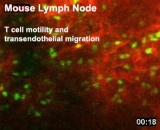
|

|
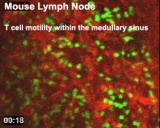
|
| Transendothelial migration | T cell zone | Medullary sinus |
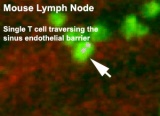
|
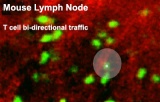
|
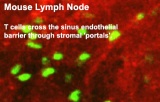
|
| Sinus endothelial barrier | Bi-directional traffic | Cross the sinus endothelial barrier |
References
- ↑ <pubmed>19060331</pubmed>
- ↑ <pubmed>19644499</pubmed>| PMC2785037 | Nat Rev Immunol.
- ↑ <pubmed>16273098</pubmed>
- ↑ <pubmed>18173372</pubmed>
Textbook
Immunobiology 5th edition The Immune System in Health and Disease Charles A Janeway, Jr, Paul Travers, Mark Walport, and Mark J Shlomchik.
Part I. An Introduction to Immunobiology and Innate Immunity
- Chapter 1. Basic Concepts in Immunology
- The components of the immune system
- Figure 1.3 All the cellular elements of blood, including the lymphocytes of the adaptive immune system, arise from hematopoietic stem cells in the bone marrow
- Figure 1.4 Myeloid cells in innate and adaptive immunity
- Figure 1.5 Lymphocytes are mostly small and inactive cells
- Figure 1.6 Natural killer (NK) cells
- Figure 1.7 The distribution of lymphoid tissues in the body
- Figure 1.8 Organization of a lymph node
- Figure 1.9 Organization of the lymphoid tissues of the spleen
- Figure 1.10 Organization of typical gut-associated lymphoid tissue
- Figure 1.11 Circulating lymphocytes encounter antigen in peripheral lymphoid organs
- Summary to Chapter 1
- The components of the immune system
Part III. The Development of Mature Lymphocyte Receptor Repertoires
- Chapter 7. The Development and Survival of Lymphocytes
- Generation of lymphocytes in bone marrow and thymus
- Figure 7.3 The early stages of B-cell development are dependent on bone marrow stromal cells
- Figure 7.5 The development of a B-lineage cell proceeds through several stages marked by the rearrangement and expression of the immunoglobulin genes
- Figure 7.7 The cellular organization of the human thymus
- Figure 7.13Thymocytes at different developmental stages are found in distinct parts of the thymus
- Survival and maturation of lymphocytes in peripheral lymphoid tissues
- Summary to Chapter 7
- Generation of lymphocytes in bone marrow and thymus
Reviews
<pubmed></pubmed>
Articles
<pubmed>165702</pubmed> <pubmed>1167215</pubmed>
Glossary Links
- Glossary: A | B | C | D | E | F | G | H | I | J | K | L | M | N | O | P | Q | R | S | T | U | V | W | X | Y | Z | Numbers | Symbols | Term Link
Cite this page: Hill, M.A. (2024, April 19) Embryology Lymph Node Development. Retrieved from https://embryology.med.unsw.edu.au/embryology/index.php/Lymph_Node_Development
- © Dr Mark Hill 2024, UNSW Embryology ISBN: 978 0 7334 2609 4 - UNSW CRICOS Provider Code No. 00098G
